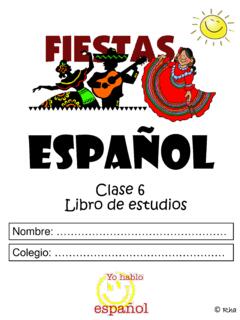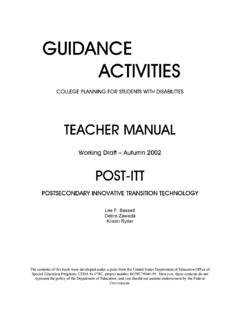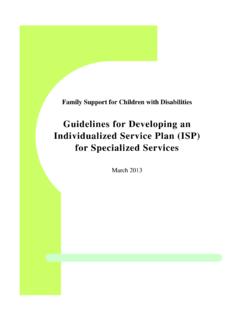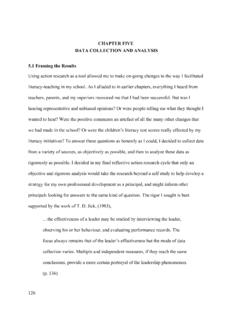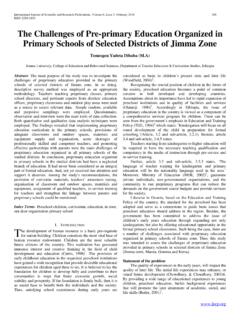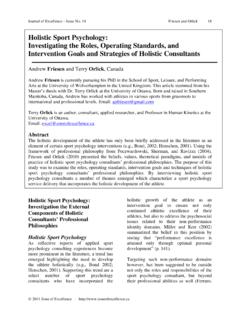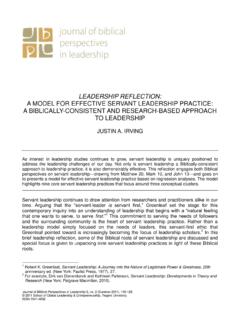Transcription of Learning to talk and talking to learn: how spontaneous ...
1 Learning to talk and talking to learn: how spontaneous teacher -learner interaction in the secondary foreign languages classroom provides greater opportunities for L2 Learning . Rachel Hawkes Homerton College A dissertation submitted for the degree of Doctor of Philosophy at the University of Cambridge January 2012 2 Declaration This dissertation is the result of my own work and includes nothing which is the outcome of work done in collaboration except where specifically indicated in the text. I further state that no substantial part of my dissertation has already been submitted, or, is being concurrently submitted for any such degree, diploma or other qualification at the University of Cambridge or any other University of similar institution except as declared in the Preface and specified in the text.
2 Finally, I confirm that this dissertation does not exceed the prescribed word limit. Date: 5 January 2012 Signature: Name: RACHEL HAWKES 3 Summary This study sets out to investigate classroom interaction within the secondary foreign languages classroom, analysing spontaneous teacher -learner L2 interaction in three classes of beginner learners of German. The lack of spontaneous L2 interaction in secondary foreign language classrooms in England has been of central concern for as long as Communicative Language Teaching has been the dominant pedagogical approach. Professional and pedagogical impetus for an enquiry into L2 talk in the English school context is provided by OFSTED school inspection report findings that spontaneous L2 interaction is all but absent, and the knowledge that the classroom typically represents the main, if not only, source of language experience for learners in England.
3 Whilst the precise nature of the relationship between interaction and L2 Learning remains undetermined, it is nevertheless broadly accepted within the field of Second Language Acquisition that greater opportunities for interaction benefit L2 learners. Within a sociocultural approach to Learning , talk is especially privileged as the locus of Learning itself, and yet in spite of the theoretical imperative of talk for Learning , the vast majority of L2 studies to date have focused on conceptual gains in language Learning through dialogue about the L2, rather than meaning-focused interaction in the L2. Furthermore, the context for Learning has most often been one-to-one tutorial or peer-peer interactions rather than whole class teaching.
4 This study is an interpretive, comparative case study of three classes (two project classes and a control class) of secondary school learners of German in their second year of study. The flexible Action Research design combines instrumental case study with a quasi-experimental element, involving an intervention programme of teacher strategies designed to promote higher levels of spontaneous L2 talk in whole class teacher -fronted interaction. Its overall purpose is to contribute to the development of a theory of L2 use within classroom-based foreign language teaching and Learning , with respect to the role of spontaneous teacher -learner interaction and in particular to the role of the teacher s dialogic support in L2 Learning .
5 The intervention strategies were based on a synthesis of empirical classroom interaction research studies and sociocultural theoretical perspectives. The general principles, however, relied on individual teacher interpretation and elaboration in the classroom and the interactions generated as a result were analysed. An initial descriptive analysis identified key patterns of interaction, thereafter a fine-grained microgenetic analysis of episodes of spontaneous talk, supported by secondary data from teacher and learner interviews, revealed L2 development in linguistic and 4 communicative competence, and pinpointed aspects of teacher talk that scaffold learner contributions.
6 The study s findings provide evidence that participation in spontaneous talk initiates learners into a broader range of interactional practices that they enjoy within IRE-dominated classroom discourse. In addition, conversational interaction affords learners opportunities to acquire new lexis and to gain greater control over their existing linguistic resources. Strategic teacher -talk moves that trigger increased and improved learner L2 talk are identified. They extend and refine the construct of scaffolding , showing how the teacher s dialogic support is enacted in L2 classroom interaction. The dyadic teacher -learner interactions played out within the whole class setting represent, furthermore, a rich cultural artefact for other learners in the class, who interact with it, and other forms of mediation, creating their own ZPDs and benefitting vicariously from the Learning situation.
7 In its analysis of spontaneous teacher -learner L2 talk in the secondary foreign languages classroom, the present study captures in flight instances of Learning to talk and talking to learn. The contribution to L2 development of such talk is sufficiently supported by the study s empirical findings as to suggest that they might justifiably be projected onto similar contexts in instructional settings, with the expectation of similarly positive outcomes. 5 Dedication I dedicate this thesis to my husband Mark and children Emily and Tom, whose unfailing faith in me gave me the perseverance to complete it. 6 Acknowledgements I would like to thank my supervisor, Dr Michael Evans, without whose advice and guidance, wisdom and experience, patience and encouragement, the work presented in this dissertation would not have been possible.
8 I am also deeply grateful to the three teachers who collaborated with me in this action research study. Their energy and enthusiasm before, during and since the project helped to sustain my commitment to this work. I am further indebted to them for sharing the thoughtful insights into language teaching that they developed along the way and for continuing to develop their own and others classroom practice in spontaneous talk. I want also to thank Silke Pfannkuch, colleague and friend, who gave freely of her time to aid me in the transcription process. I owe a particular debt of gratitude to the students I teach for providing me with the initial source of interest in this research project and, in addition, to the three classes of learners that became the focus of it.
9 Without their Learning processes there would have been no reason for mine. The Faculty of Education has offered a great deal of support and I would like to extend my thanks in particular to the library team and the PhD administrator. And finally, I would like to thank my parents, my husband and my children, who have always given me unconditional love and support in everything I do. The teacher s paradox: We seek in the classroom to teach people how to talk when they are not being taught. Edmondson (1985:162) 7 Table of contents Page Declaration 2 Summary 3 Dedication 5 Acknowledgements 6 Table of contents 7 List of tables and figures 11 List of abbreviations 13 List of appendices 13 Chapter 1: Introduction 14 Part 1 Chapter 2.
10 Literature review (1) 22 Sociocultural theory 25 Key concepts within SCT for interaction and Learning 25 Mediation and microgenesis 26 The Zone of Proximal Development 27 Scaffolding 28 SLA studies within the sociocultural paradigm 31 L2 development through scaffolding as corrective feedback 31 L2 development through scaffolding in peer-peer collaboration 36 L2 development through meaning-focused interaction 41 Conclusion 43 Chapter 3: Literature review (2) Classroom interaction and discourse 45 Initiation-response-evaluation/feedback 45 The evaluation/feedback third turn 46 Questioning 48 teacher learner discourse roles 49 SCT-based studies of teacher -learner interaction in whole class teaching 50 spontaneous /unplanned talk within mainstream SLA 51 spontaneous talk within SCT 52 spontaneous talk in the languages classroom: learner initiations 53 Conversation 53 Conversation or dialogue?

